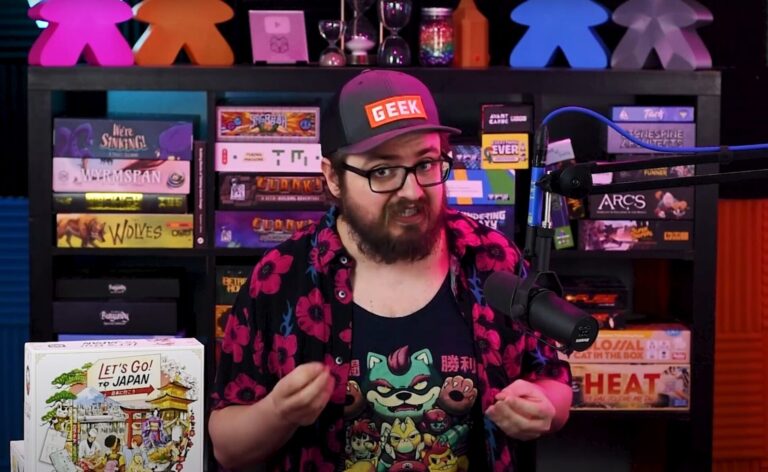
“Influencer impact was judged to be quite high. I think that tide is receding”: Alderac’s veteran COO on how to master board game crowdfunding
Alderac Entertainment Group‘s veteran COO Ryan Dancey has managed more than 20 crowdfunding campaigns during his long career – and is currently overseeing another Kickstarter success with Wingspan designer Elizabeth Hargrave‘s latest offering, Undergrove. In this in-depth guide he picks out every aspect of the crowdfunding process designers and publishers need to nail in order to run a successful campaign.

The first campaign I oversaw was for Pathfinder Online, and it ran in June of 2012, so I’ve been crowdfunding for more than a decade. All but one of those campaigns funded, and collectively they raised over $8m, with substantially more raised post-campaign via pledge managers. All but two of those campaigns were in the tabletop boardgaming space (the first two were for an online game). My first boardgaming campaign ran in 2017.
The best practices for crowdfunding don’t change, but the details certainly do. There is now a small constellation of service providers ready to assist creators with marketing, fulfillment, industrial design, graphic and video asset creation, translation and localization, etc. Kickstarter says that in 2022, $236m was pledged on its platform in the tabletop gaming category. That’s a lot of money funding a tremendous ecosystem. It is a sum larger than the combined annual revenues for all tabletop game publishers combined except the large European publishers Hasbro, Mattel, and Games Workshop, probably as recently as 2015 – and perhaps even more recently. Crowdfunding has been transformational for the business of publishing tabletop games.
Monetize Your Audience
The most important advice I give to people considering crowdfunding is that crowdfunding is a way to monetize your audience, not a place to build an audience. Most successful campaigns have created awareness and interest with a sizable community before they launch. Without that kind of support odds of a successful campaign are low.
Since crowdfunding has become a mainstream way to market and sell products in the boardgaming space it’s become less useful over time to share lists of things that first time creators should know or do. There are excellent resources accessible via quick searches on the internet for that kind of assistance. I like to focus on things I’m learning now that help seasoned campaigners increase their success.

The first question that a team has to evaluate is where to run their campaign. All of my campaigns have been run on Kickstarter. I have evaluated many different options over the years and so far none of them have crossed the threshold I would need to see to take a risk on using them. AEG has the benefit of having been on Kickstarter a long time, having a good relationship with their Trust & Safety team, and a track record of performance and delivery to backers so we have the capability to run the kinds of campaigns on the cadence we want; new creators won’t have that level of flexibility and that may prove decisive in where they choose to host their campaigns. The reason I prefer Kickstarter to the other options is purely the value they deliver in terms of their audience and their audience’s proven interest in discovering and backing the kinds of games we make. No other platform has as large or active an audience. The network effect is real. Several of Kickstarter’s competitors have features and services that I find highly desirable but the probable return on investment offered by Kickstarter outweighs my desire to get access to better technology. All of that comes with the strong caveat that we continually evaluate our options and could, at any time, decide to run a campaign off of Kickstarter if we felt there was a strong case to be made for doing so.
I tell project managers that the bar for success is high. The days of campaigns with low quality assets and support are over. Backers expect to see very good, polished campaigns. They’ll judge the potential quality of your game based on the quality of your campaign. If you don’t have great video and graphic assets, a good looking prototype, clear and compelling text, and all the details for things like shipping & tax, backers will assume that the game you’re pitching will not be good value and they’ll likely pass on the opportunity to participate. You should study the best performing campaigns and try to understand the level of excellence they presented to backers, then do your best to meet that bar.
Not All Influencers Have Impact
The industry went through a cycle where influencer impact was judged to be quite high. I think that tide is receding; and frankly I wonder if it was ever as significant as we collectively thought it was. Studying the numbers, I see a small number of influencers who seem to have an outsized impact and a lot who don’t. I also think that who is impactful and who is not can vary based on subcategories of games and audiences, so there’s no universal ranking metric. Unfortunately (from a marketing perspective) most of the high-value content creators are also the people least likely to be interested in a sponsored relationship. If they choose to highlight your project you’ll see a lot of benefit but there’s very little you can do to incentivize them to do so. I think that when a project manager is considering working with influencers they should take a high-level view of how much that influencer’s content is being accessed by the public compared to their peers and to the superstars. I’m not saying that influencer marketing is dead, but I am saying that making it have a meaningful impact is hard.

With regard to marketing, my advice to project managers is to focus your marketing on your email list and social media marketing, particularly Facebook. The most important event in your campaign is launch day; most campaigns have an extremely predictable funding curve that is determined by the total amount of funds raised the day you launch. We think that the best way to maximize launch day is to get as many prelaunch Project Followers as you can, and we work hard to drive people to the prelaunch page on the crowdfunding platform and encourage them to follow the project. We’ve tried a lot of different promotional ideas to maximize Project Followers and so far we have not found a magic bullet, but we do have good data that shows that making some offer to backers that you can track – like signing up for your mailing list – does have a positive effect on the numbers.
Working with a service provider for marketing support can be a good choice for many teams. Making social media marketing work well is hard; if you don’t have someone on your team with the necessary expertise, paying a provider may be the best option. They’re expensive, but they do deliver. Every project has to evaluate the return on investment and rightsize their budget for marketing and for marketing support but spending nothing on marketing is almost always a huge mistake.
Fulfilling Your Promises
Once your campaign is over you’ll find that you have more work to do and that work is some of the most critical for the entire project. You’ll want to have lined up a reputable pledge manager solution and have it turned on to take late orders immediately after your campaign ends. I have worked with several, including a homebrew, and my recommendation today is to go with BackerKit; but I continue to evaluate other options and don’t think there’s a single solution that works for every campaign. Your choice of pledge manager has a lot of downstream impact on other business processes you’ll need to be aware of – dealing with customer service, planning your production runs, preparing and executing fulfillment, tax matters, etc. Compared to the impacts of the pledge manager, the crowdfunding platform itself is usually a minor driver of those post-campaign activities.

Most tabletop game campaigns plan to fulfill worldwide. Gaming is a truly international business. You should have a firm plan on how to handle a complex fulfillment operation. At AEG, we partner with six “depots” who receive inventory in various regions around the world, warehouse product, and fulfill orders to the customers in their regions. In the past we used Ship Naked, who became Funagain, as a one-stop solution but that entity has exited the business and we have not felt comfortable with other partners. We invested the time and resources to develop direct relationships with companies in the regions we service and now we act as our own global fulfillment coordinator. It is a tremendous amount of work – ensuring that shipments are handled correctly, importation is smooth, and data exchange with the Depots is accurate requires full time staff.
When we first began crowdfunding we offered fulfillment everywhere in the world except the really troublesome destinations. After being repeatedly burned by failures to deliver, stolen packages, fraud, and other nonsense, we’ve restricted our fulfillment to Australia & New Zealand, Canada, the EU, the UK, the United States, and in Asia we ship to China, Japan, South Korea, Taiwan and Singapore. We’ve lost a few backers but we’ve also escaped a lot of cost & hassle (and angry backers disappointed at delivery failures).
Taxing Times
Over the past several years issues of taxation have really come to the forefront as matters of concern. A lot of US based companies had a very lax attitude towards tax, especially VAT in the EU and the UK. Those days are over. You should expect to be required to present tax certifications when you do business outside the US. Compliance with these tax matters is extremely onerous. None of the crowdfunding platforms and none of the pledge managers have managed to reduce this to a simple process for reporting. You will need to be prepared to extract data from the sources of revenue, parse it into the necessary formats you’ll need to prepare tax returns, and then process those returns, usually monthly. We are using a company named SimplyVAT to assist us with filing in the EU and the UK; we use Avalara for US and Canadian tax matters, and we’re continuing to evaluate our needs and options in other jurisdictions.
Even though crowdfunding requires a lot of time, resources and attention, I believe it is still the very best way to bring new boardgames to the global audience for gaming. There’s never been a time when a publisher could work directly with hundreds of thousands, maybe millions, of gamers around the world to make a connection and deliver great new products to the players in the way that crowdfunding enables. The way that crowdfunding de-risks the publication of games allows publishers to take risks we could never justify using other channels of distribution. And the discovery and sharing of campaigns makes players aware of games and publishers they might never otherwise have any knowledge of. It is truly a win/win situation for everyone involved.
All of the leadership at AEG has a policy of being interested in helping and giving back to the community. We received so much support from our peers and those who came before us that we feel obligated to continue to pay that help back wherever we can. I am happy to reply to enquiries about crowdfunding or any other topic related to gaming or business development; I can be reached at rdancey@alderac.com.






